How Worm&Co works
Lorem ipsum dolor sit amet, consectetur adipiscing elit. Curabitur varius orci vulputate mi faucibus, eget mollis velit interdum. Nullam tincidunt rhoncus turpis, vel bibendum magna vehicula ut. Nulla luctus rutrum metus sed pharetra. Morbi in odio libero. Quisque hendrerit ligula sit amet malesuada congue. Sed facilisis suscipit orci, ut rhoncus risus egestas vitae. Nunc hendrerit nunc ullamcorper ipsum placerat tristique. Nunc semper porta magna eget dapibus. Ut ut facilisis augue, eu eleifend arcu. Donec vitae dui nunc. Sed quam nisl, cursus euismod nisi in, ullamcorper auctor magna. Maecenas eget arcu non metus aliquam laoreet.
We request that you read the instructions carefully in step 1. We cannot have a manure test carried out without the information on the label. Would you like to receive immediate advice? Update your questionnaire in your account. Important: if you do not have an account yet, we would like to ask you to register once.
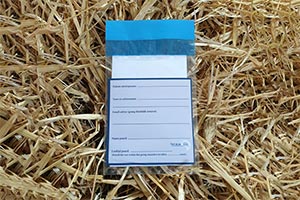
Fill in label
Manure research kit purchased from Worm&Co: enter the date of manure intake on the label and check the available data. Manure examination kit purchased in the store: enter the date of manure intake, your email address, name and age of the horse on the label.
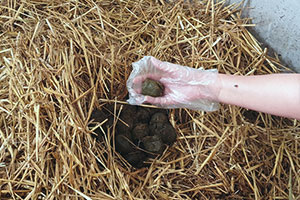
Collect manure ball
Put on the glove and take 1 fresh manure ball that has not been in contact with the ground. It is not necessary to collect multiple manure balls. 1 manure ball is sufficient for a qualitative study.
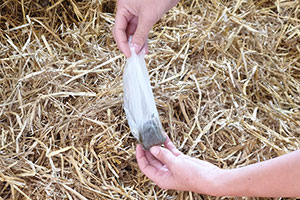
Filling bag
Place the bag over your hand so that the fertilizer ball ends up on the inside of the bag.
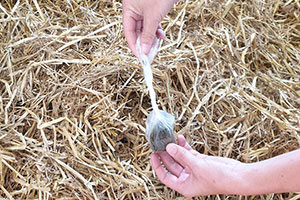
Seal the bag
Twist the end of the bag around a few times and fold it around the manure ball. Please note: do not tie a knot in the bag!
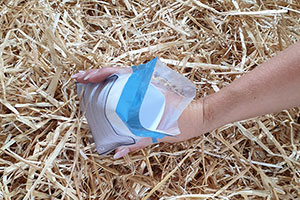
Place in safety bag
Take the safety bag with the blue adhesive strip and apply pressure to the blister on the inside to create an opening. Place the bag with the manure sample in the safety bag.
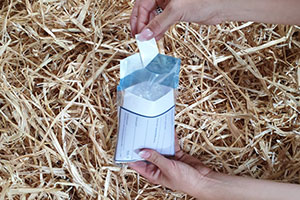
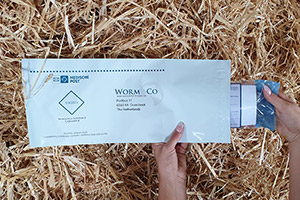
Place in return envelope
Place the safety bag in the return envelope. A maximum of 5 manure samples can fit in 1 return envelope) Seal the return envelope or box tightly and, if ordered without postage, provide sufficient postage.
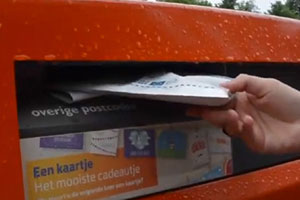
Send manure research
Preferably post the same day. If you have a standard return envelope, you can send it via the letterbox. Is it a large return bag or box? We then request that you hand it in at a PostNL point.
We request that you read the instructions carefully in step 1. We cannot have a manure test carried out without the information on the label. Would you like to receive immediate advice? Update your questionnaire in your account. Important: if you do not have an account yet, we would like to ask you to register once.
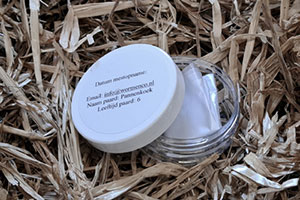
Fill in label
Manure research kit purchased from Worm&Co: enter the date of manure intake on the label and check the available data. Manure examination kit purchased in the store: enter the date of manure intake, your email address, name and age of the horse on the label.
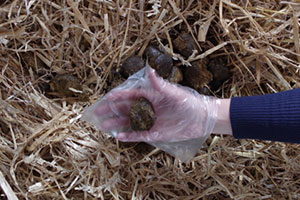
Collect manure ball
Put on the glove and take 1 fresh manure ball that has not been in contact with the ground. It is not necessary to collect multiple dung balls: 1 dung ball is sufficient for a qualitative study.
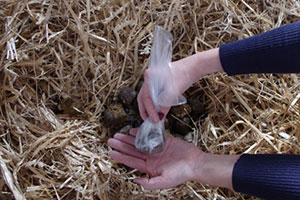
Filling bag
Place the bag over your hand so that the fertilizer ball ends up on the inside of the bag.
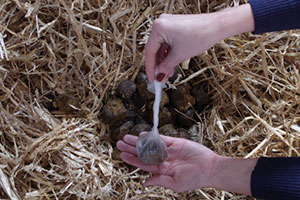
Seal the bag
Twist the end of the bag around a few times and fold it around the manure ball. Please note: do not tie a knot in the bag!
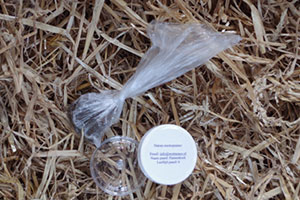
Prepare manure ball
Take the manure sample container and then flatten the manure ball slightly.
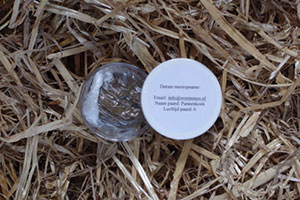
Place in manure sample container
Place the glove with the manure ball in the manure sample container. Close the lid properly so that the manure sample cannot leak. Multiple manure samples returned at the same time? Then repeat steps 1 to 7.
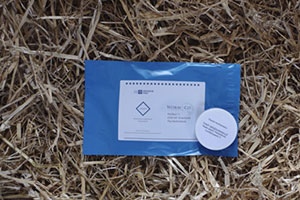
Place in return envelope
Place the manure sample container in the return envelope. A maximum of 4 manure samples fit side by side in 1 small return envelope. Seal the return envelope or box tightly and, if ordered without postage, add sufficient postage.
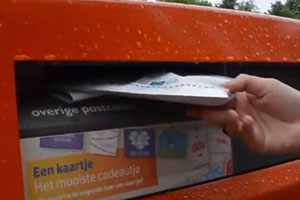
Send manure research
Preferably post the same day. If you have a standard return envelope, you can send it via the letterbox. Is it a large return bag or box? We then request that you hand it in at a PostNL point.
We request that you read the instructions carefully in step 1. We cannot have a manure test carried out without the information on the label. Would you like to receive immediate advice? Update your questionnaire in your account. Important: if you do not have an account yet, we would like to ask you to register once.
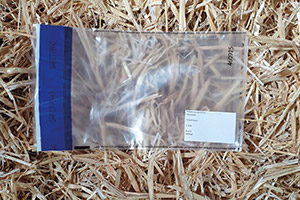
Control data
Check the information on the label and enter the date of manure intake.
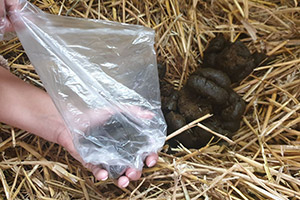
Collect dung balls
Pull the plastic bag on your hands and collect 3 to 4 fertilizer balls that have not been in contact with the ground.
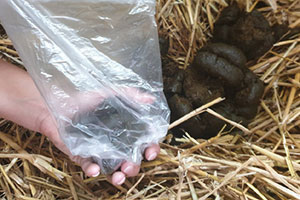
Filling bag
Place the bag over your hand so that the manure balls are on the inside of the bag.
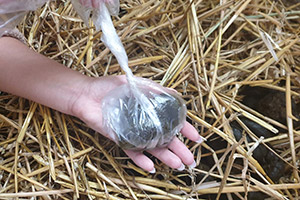
Seal the bag
Turn the bag with the fertilizer balls around a few times, flatten the fertilizer ball slightly and fold the end around the whole. Please note: do not tie a knot.
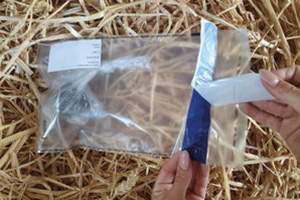
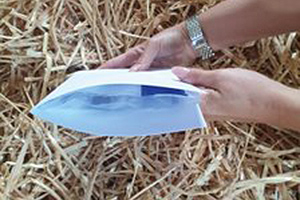
Place between cardboard
Place the safety bag between the cardboard. If you send multiple manure samples in one return bag, you can omit the cardboard and place the closed safety bags directly in the return envelope.
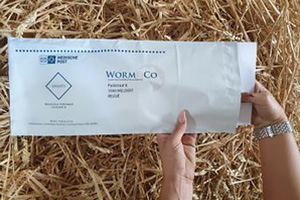
Place in return envelope
Place the cardboard with safety bag in the return envelope (a maximum of 2 manure samples can fit in the standard return envelope). More than 2 manure samples? Then place the manure samples in the large return bag provided. Seal the return envelope tightly and add sufficient postage.
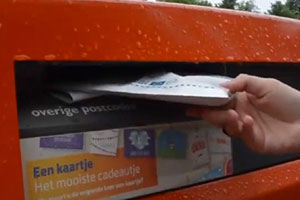
Send manure research
Preferably post the same day. If you have a standard return envelope, you can send it via the letterbox. Is it a large return bag or box? We then request that you hand it in at a Post Point.
The EquiSal Tapeworm test is an innovative saliva-based test that shows whether your horse carries a harmful tapeworm infection. The test is user-friendly. The horse owner can collect the saliva himself with the supplied swab, which changes color once sufficient saliva has been collected. It is essential that the horse does absolutely no work and does not eat or drink at least half an hour before the saliva sample is collected. Failure to follow instructions correctly may affect test results.
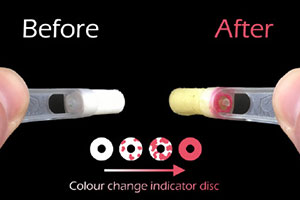
Place barcode label
Write the horse's name on the storage tube. Apply a barcode label from the packing slip lengthwise to the side of the storage tube.
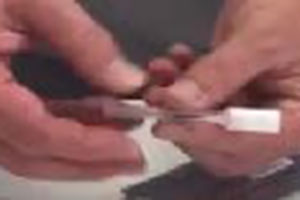
Unpack saliva test
Make sure your hands are clean and remove the saliva test from the foil package. The cotton swab will tell you when you have collected enough saliva with a color indicator. Firmly grasp the plastic end of the swab and keep the saliva storage tube handy.
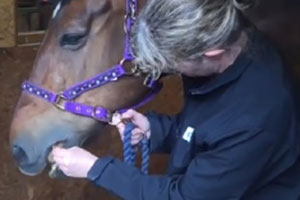
Taking a saliva test
Insert the swab behind the front teeth through the interdental space and place the swab on the tongue. The horse now moves its tongue back and forth along the swab. Do not allow the horse to chew the swab while collecting saliva.
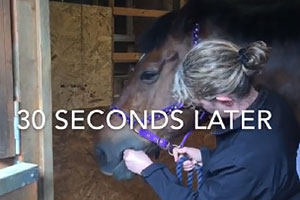
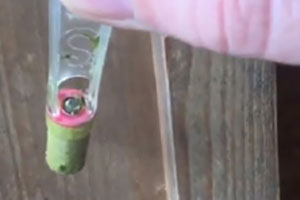
Control indicator
Note: It is important not to stop sampling until the entire indicator is colored bright pink.
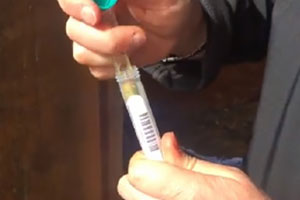
Close storage tube
As soon as the indicator disc has completely changed to bright pink, the sample has been collected correctly. Place the swab in the storage tube, taking care not to spill and to close the storage tube properly!
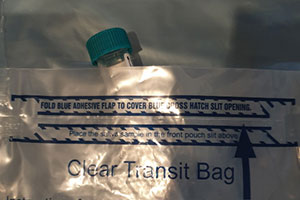
Filling transit bag
Place the storage tube containing the swab into the clear transit bag. Place the completed paper and comments in the appropriate box and seal the bag. Leave the absorption material in place: this is there to absorb any leakage.
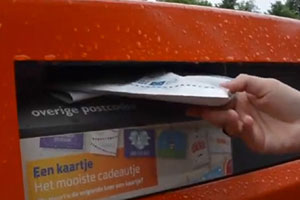
Send saliva test
Preferably post the same day. Do not store in the freezer. If you have a standard return envelope, you can send it via the letterbox. Is it a large return bag or box? We then request that you hand it in at a PostNL point.



